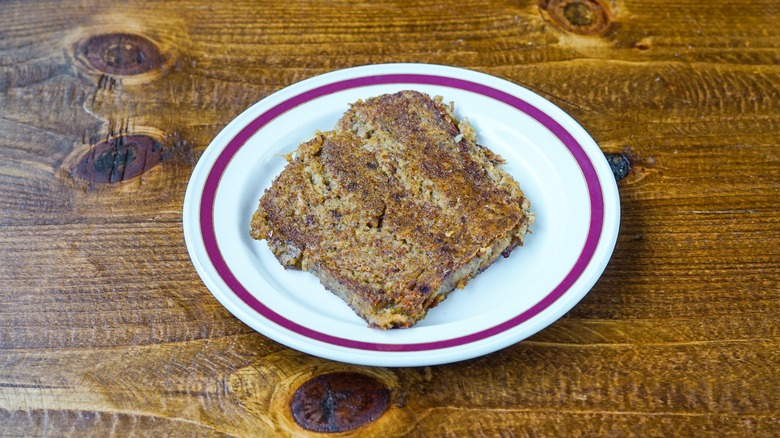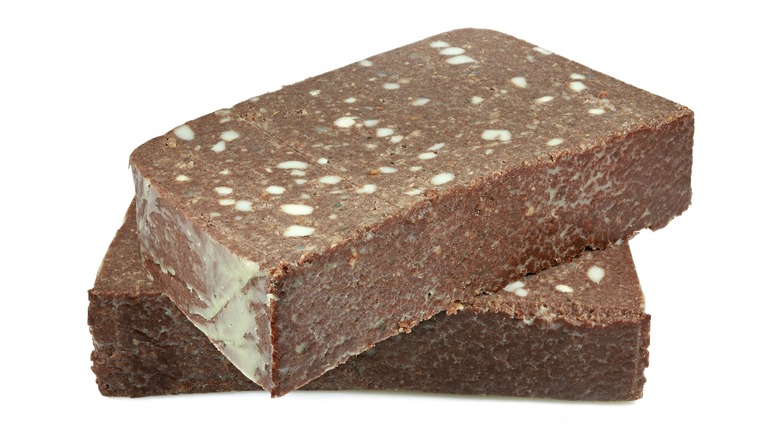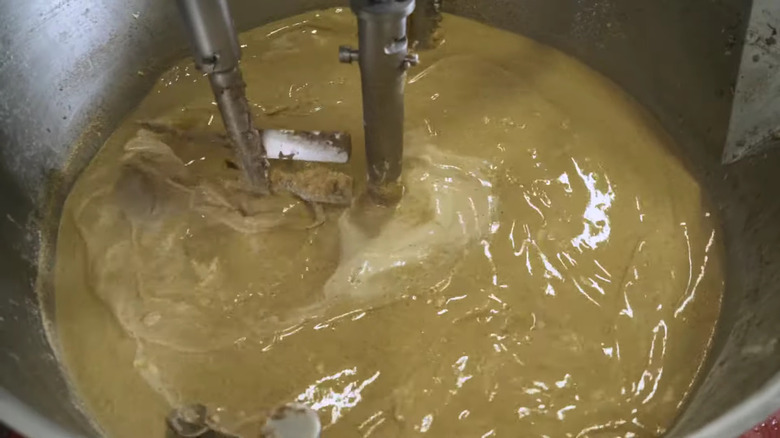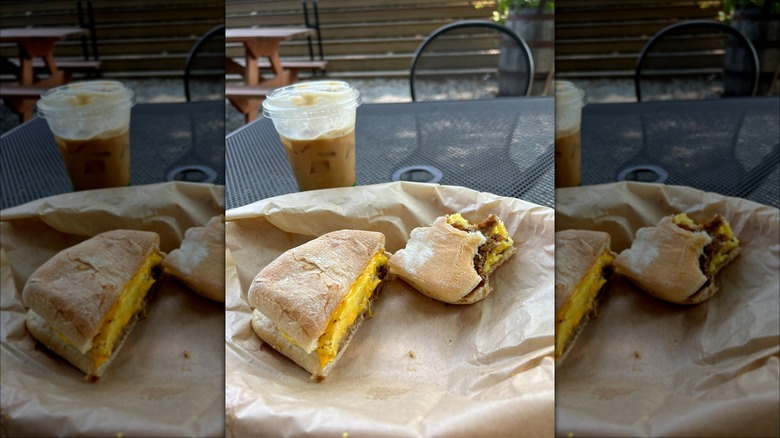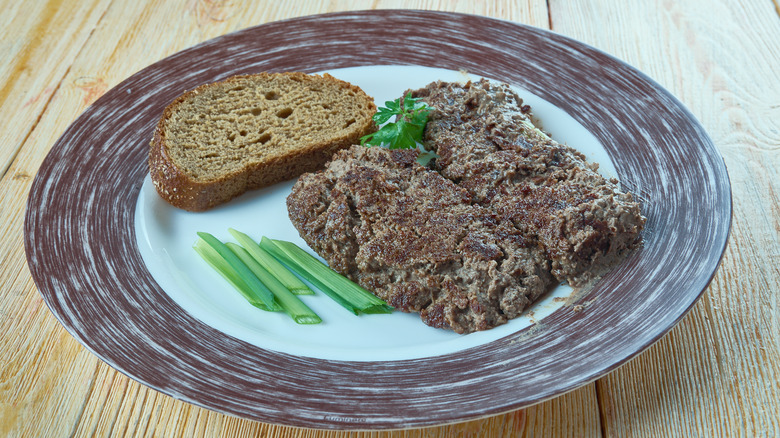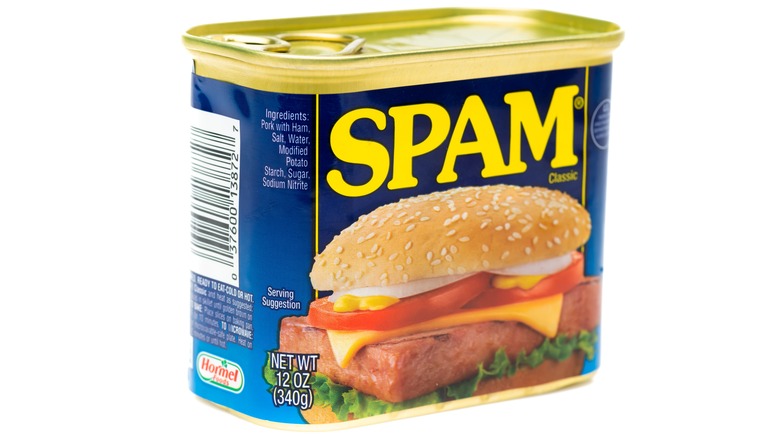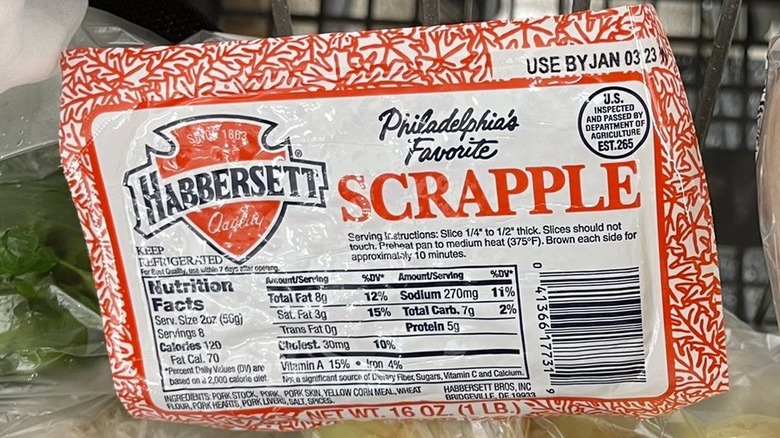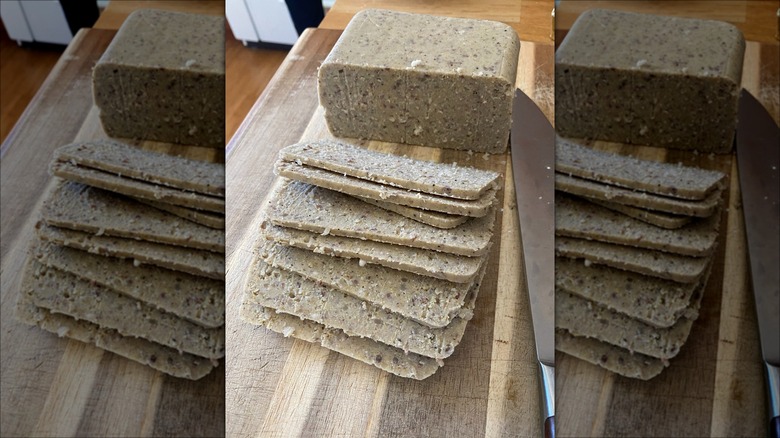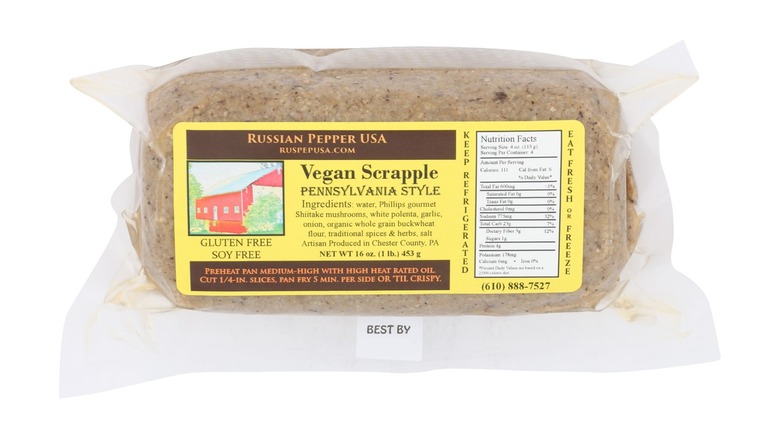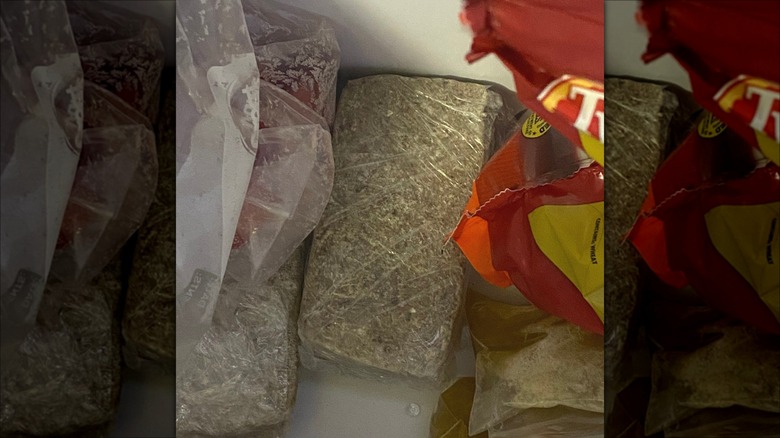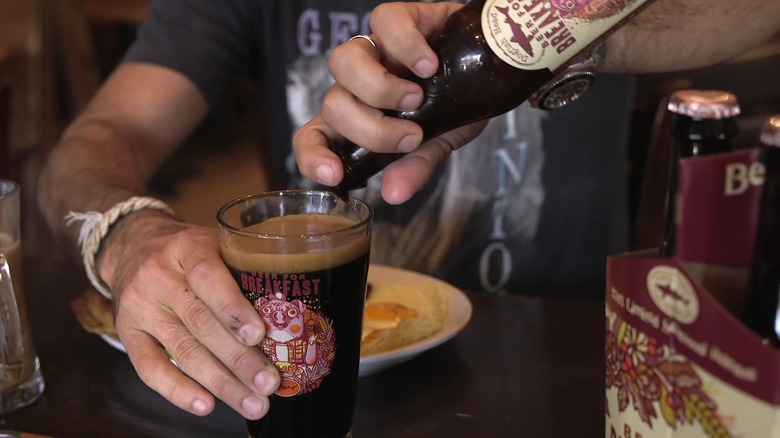What Is Scrapple And What Does It Taste Like?
Many traditional foods have their foundation in frugal cooking practices — our ancestors did not have food to waste, so every part of the plant or animal was put to good use. Few foods embody frugal cooking as well as scrapple, a pork-based loaf made, as the name suggests, from the scraps of butchered pig carcasses.
Scrapple is most popular in America's mid-Atlantic states, where it is routinely enjoyed for breakfast. Yet, as is the case with many regional American foods, scrapple is often overlooked and undervalued outside of its American heartland. This is a shame, as the pork product promises immense flavor and moreish textural contrasts when prepared and cooked correctly.
The predominant cause of scrapple being overlooked is that many people have never tried it and don't know the first thing about it. This article attempts to right that wrong, providing you with all the scrapple-related information you could possibly need.
What is scrapple?
Scrapple is a traditional food made and popularized by German immigrants who settled in America between 1683 and 1820. Mistakenly labeled the Pennsylvania Dutch, these individuals introduced a whole host of German foods.
Scrapple, like many other popular Pennsylvania Dutch foods, is pork-based. Usually, scrapple takes the form of a loaf made from pieces of pork — including offal — that are left over after the animal has been butchered. Stock, thickeners, and seasonings are added during the cooking process to form the finished product.
Although it is hard to find elsewhere in the United States, scrapple is still enjoyed in the Mid-Atlantic states today due to its origins. Scrapple's popularity is limited outside of this area for one simple reason: Descriptions of scrapple tend to put off Americans who are unfamiliar with the product. This, in turn, stems from many eaters in modern American society's avoidance of foods that contain offal.
How is scrapple made?
Scrapple is made from all parts of the pig that are leftover after traditional butchering processes have taken place. These leftovers can include a huge range of cuts, including offal, trotters, and pork butt. No matter which of these are used, all cuts are boiled in water. This not only cooks the meat but also causes the gelatin to seep out of any cartilage and into the broth, acting as a natural binding agent when the scrapple is cooled.
After cooking, the meat is removed, finely chopped, and reintroduced to the pot with any seasonings. Thickener in the form of flour is then added. Although several varieties can be used, buckwheat flour is the most popular as it gives the scrapple a lighter texture. Once the flour has been added, the mixture is then poured into molds and left to set. This will take around three hours if the scrapple is put in the fridge. After it has set, the scrapple can be cut and fried up or eaten cold.
Scrapple vs. goetta
Scrapple is not the only scrap-style meat product made in such a way. In fact, there are several similar food products that share many characteristics with scrapple. One of these is goetta, a breakfast sausage traditionally made in Northern Kentucky and Cincinnati.
Unsurprisingly, goetta was also brought to the United States by German immigrants, as was explained to Spectrum News 1 by sausage maker Dan Glier: "Goetta is a peasant food from Germany. It was not known as goetta in Germany. It's known as grutzwurst over there, or grits, grain, wurst, sausage, grain sausage. It was brought over by the early immigrants, probably in the late 1800s. And almost all of it was home cooked."
Despite their similarities, goetta and scrapple are not the same thing. One difference is that goetta is thickened with oats instead of flour. This gives the sausage a much more varied texture than the fine-grained scrapple. What's more, goetta can also contain both pork and beef whereas scrapple traditionally only includes pork.
Scrapple vs. livermush
Livermush is another scrapple-esque meat product. This breakfast sausage is also made from pork that is boiled and mixed with thickeners before setting. Yet, unlike both goetta and scrapple, livermush is most definitely a U.S. Southern dish, with historical roots in North Carolina.
As with scrapple, the best livermush is made with a variety of pork cuts. While pork shoulder is often used, it is the inclusion of pork liver that defines livermush. This gives the livermush a distinct richness and slight bitter flavor that is not often present in scrapple. The reduced proportion of other pork scraps also means that livermush has a much finer texture than scrapple.
While different, both scrapple and livermush are enjoyed in similar ways — livermush is sliced, fried, and served at breakfast to Southerners of all ages. Fried livermush slices are also often included in sandwiches alongside mustard or, in true Southern fashion, atop biscuits.
Scrapple vs. Spam
Given scrapple's rectangular shape and porcine origins, many instantly equate it to Spam. This is a mistake, as the two differ in a number of ways. The most prominent difference is the meat that is used to make them. As we know, scrapple is made from a mixture of cuts including offal, giving it an intense, meaty flavor. Spam, on the other hand, is made from 'pork with ham.' This choice of meat, and lack of seasonings aside from salt, gives Spam an overwhelmingly salty flavor that is markedly different from scrapple.
The production processes also diverge. Instead of being boiled and then set, the ingredients for Spam are mixed together, sealed inside the can and then cooked in a water bath. This, along with the addition of sodium nitrite, makes the Spam shelf stable. Scrapple, on the other hand, is not. When asked about the two products' differences on Twitter, American chef Andrew Zimmern highlighted this: "Scrapple made fresh is amazing. Spam is made in a factory with chemicals, bad meat and rendered shelf stable."
What does scrapple taste like?
Scrapple is known for its intensely savory flavor. What other flavors are present, however, depends on how the scrapple has been produced. Many scrapple makers will add spices, such as sage or coriander, to the scrapple. These spices present themselves strongly in the finished product.
When asked what scrapple tastes like, one fan of the product gave this succinct reply on Quora: "It's good. It tastes primarily of sage and pork, but can also include hot peppers, and black pepper. The cornmeal used in it doesn't have a strong flavor, but it can be tasted, too, in good quality scrapple."
What the reviewer forgot to mention was that how the scrapple is prepared also affects people's eating experiences. Most enjoy scrapple when it has been fried because it creates an enticing textural contrast; the outside crisps while the interior meat remains soft and juicy. If the scrapple is cut too thick or too thin, however, this delicate balance is lost and the customer's enjoyment will be greatly diminished.
How do you cook scrapple?
While it can be eaten cold, scrapple is best enjoyed after being sliced and cooked for a second time. There are two main techniques used for cooking scrapple: pan frying and baking. When it comes to frying, plenty of oil must be used to ensure the scrapple develops its distinctive, moreish crust. Failure to do so can see the scrapple disintegrate.
For those looking for a healthier option, scrapple can also be baked. Slices are placed in a 375 degrees Fahrenheit oven for around 30 minutes. The scrapple should only be flipped once, halfway through, minimizing the chance of the slices breaking apart. This method negates the need for large quantities of oil. Fried or baked scrapple slices are often served at breakfast alongside eggs. Many other diners prefer to top their cooked scrapple with all manner of condiments, including applesauce, maple syrup, and mustard.
Where to buy scrapple
Although scrapple is a regional delicacy, it is relatively easy to find online. The best places to look are the websites of respected scrapple producers like Habbersett, a company that has been making scrapple since 1863. Habbersett produces a range of scrapple, including varieties made with protein alternatives, such as beef and turkey. Stocked in stores across Philadelphia, Habbersett ships nationwide from November through February. The company's products can also be bought on Amazon.
While not an item stocked by most grocery store chains, scrapple can be found in a select few. H-E-B is one of these. The scrapple stocked in H-E-B is Jones Dairy Farm Country Style Scrapple, which features both pig hearts and, somewhat disappointingly, corn meal. While lacking the creamy texture imparted by buckwheat flour, this product remains a solid choice. Retailing at under $4, Jones' scrapple is an accessible way for many to enjoy this regional food product.
Nutritional information of scrapple
Historically, scrapple was seen as a healthy food that, as The Montreal Gazette wrote in 1909, gave men the energy to work long days and children an advantage at school. However, scrapple is seen in a much different light today.
While high in protein, vitamins, and minerals, scrapple also contains a great deal of saturated fat and salt. In fact, one two-ounce serving of Habbersett's Original Scrapple contains 15% of an adult's recommended daily saturated fat intake and 11% of an adult's recommended daily sodium intake. As such, it is a food that should only be enjoyed in moderation.
That being said, well-made scrapple contains far fewer additives than some popular ultra-processed foods, a point made by Marlin Dietrich to MyRecipes: "People say you shouldn't eat scrapple. But you go out and eat a pizza and drink a Pepsi. What's in that? Scrapple is just meat and flour."
Varieties of scrapple
Creating scrapple from other animals is not the only means of creating new and interesting types of scrapple, however. Other producers, like Rapa Scrapple, have amped up the seasonings in some of its scrapple. One example of this is the company's Hot'n Spicy Scrapple, which gains a distinct taste through the addition of jalapeño peppers.
Given the rise of meat-free alternatives, it was only a matter of time until a vegan scrapple entered the market. Russian Pepper USA, a Pennsylvania brand, has duly delivered. Its Vegan Scrapple is made with shiitake mushrooms and polenta in place of meat. One person who tried this product stated on Reddit: "My wife picked some of this up for me at the Chadds Ford WF. It's figging [sic] amazing. I'm embarrassed to say that scrapple was one of my favorite things ... This was so close to realistic scrapple that it was scary."
How to store scrapple
Scrapple is not shelf stable. This means it must be stored carefully lest it become a haven for potentially harmful bacteria. Happily, scrapple can be stored in both the fridge and the freezer.
When refrigerating scrapple, it is important to note whether it is in sealed packaging or not. If it is, it should last up to 90 days in the fridge. When it is not, the scrapple will only last about a week. Frozen scrapple can last for about half a year before going bad. When it comes to using frozen scrapple, slices can be thawed overnight in the fridge or they can be cooked from frozen.
Both methods of storing scrapple are improved if the loaf is pre-sliced and wrapped in plastic wrap. This not only limits the amount of air that comes into contact with the scrapple but also helps hold the delicate scrapple together throughout the storing process.
Modern takes on scrapple
As a historic food, scrapple has been a source of inspiration for decades. As we have seen, new takes on the loaf have included alternative protein sources and new flavorings. However, two modern takes on scrapple stand head and shoulders above the rest in terms of ingenuity.
The first of these is Dogfish Head's Beer for Breakfast stout. This beer includes a variety of ingredients in the brewing process, including scrapple. Thankfully, scrapple's flavor does not overpower the beer, as highlighted by Sam Calagione, Dogfish's founder, to Men's Journal: "In descending order of flavor/aroma impact for the beer as a whole: roasted coffee, maple syrup, applewood smoked barley, and fourth would be scrapple. The scrapple adds a subtle earthy, smokey note."
Beer is not the only alcoholic beverage being made with scrapple. Painted Stave, a Delaware-based craft spirit company, has created Off the Hoof, a vodka flavored with scrapple. This intensely savory vodka has been made with cocktails in mind, although that doesn't mean you can't enjoy it on the rocks.
